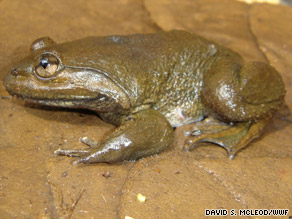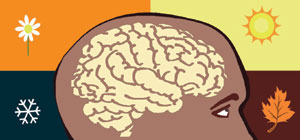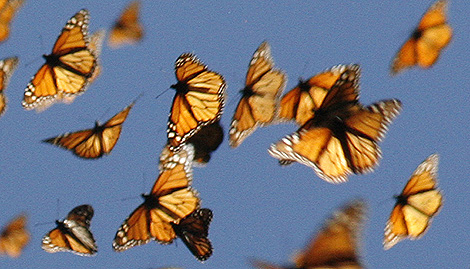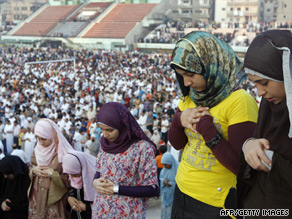
Tu situación actual no es lo que eres, es sólo el residuo de tus pensamientos y acciones pasados.
MY DAILY LIVING, CONCERNS, INTERESTS, MOSTLY GOOD NEWS TO BRIGHTEN EVERYBODY UP.

(CNN) -- A frog that eats birds and a gecko with leopard stripes are among the 163 new species discovered last year in the Greater Mekong region of southeast Asia, according to a report by the World Wildlife Fund.

The khorat big-mouthed frog is known for lying in wait for prey in streams.
The discovery of 100 new plants, 28 fish, 18 reptiles, 14 amphibians, two mammals and one bird species highlights the extent of the biodiversity in the region, said Barney Long, head of the WWF's Asian Species Conservation program.
"It's a melting pot of diverse habitats. It has some of the wettest forests on the planet, high mountains, and a diverse array of terrestrial and marine habitats, including the Mekong River," he said.
"We continue to find new species of fish, primates and mammals, and nowhere else compares to the amount of large mammals that have been discovered in the region. It shows how little we know about species in the region," he said. "From a biodiversity perspective, there are still huge amounts to discover about region."
The Greater Mekong consists of the countries through which the Mekong River flows: Cambodia, Laos, Myanmar, Thailand, Vietnam and Yunnan Province of China.
With 16 global ecoregions -- areas defined by their shared ecological features and animal communities -- the Greater Mekong has more protected spaces than anywhere else on mainland Asia, according to the WWF.
The colorful Cat Ba leopard gecko of northern Vietnam has large, orange-brown "catlike eyes" and a body of leopard stripes, according to a report released Friday.
Its name refers to its place of origin, Cat Ba Island, the largest of 366 islands in Cat Ba Archipelago and home to many rare species that can only be found on the island. Scientists believe the high number of species unique to the island might be due to the long separation of the island from continental Vietnam, the report says.
Limnonectes megastomias -- a fanged frog with an appetite for other frogs, insects and birds -- has only been found in three remote areas of medium-to-high altitudes in eastern Thailand.
Globally, new species of mammals are rare finds, but in 2008 alone, new species of the mouselike musk shrew and a tube-nosed bat emerged from the region. ![]() See photos of newly discovered species »
See photos of newly discovered species »
War and political unrest have kept large parts of the region, particularly Vietnam, Laos and Myanmar, off-limits to scientific exploration up until the past two decades, Long said.
Since 1997, nearly 1,200 new species have been discovered, many that cannot be found anywhere else, said Dekila Chungyalpa, director of WWF's Greater Mekong Program.
But the rapid pace of development in the Mekong region, coupled with the effects of climate change, are threatening to drive the species into extinction, Chungyalpa said.
"As we become familiar with more species in the region, our understanding of climate change and how it impacts these new species is changing," she said.
Chungyalpa said conservative estimates by the WWF project a 1-meter rise in sea level on the delta's coastline over the next decade, which will affect not only marine life, but also people who rely on the delta as a source of sustenance and employment, she said.
In 2007, the United Nations Intergovernmental Panel on Climate Change released its Fourth Assessment Report, which projected that global sea levels could rise from 18 to 59 centimeters (7 to 23 inches) over the next century based on six possible scenarios.
Already, Chungyalpa said, the area has been affected by an increase in tropical storms off the coast, which brings in more seawater and changes the flooding patterns in the delta. Some researchers, however, have questioned the link between climate change and more intense tropical storms. Apart from climate change, construction of dams and hydropower plants along the delta could further disrupt its waters, potentially displacing millions, destroying sources of drinkable water and disrupting the production of rice, Chungyalpa said.
"The delta is the rice bowl of the region. What will happen to people who depend on it if it's no longer there?" she said.
The WWF says it supports the idea of an agreement among the Mekong countries on how to respond to infrastructure development and climate change in terms of protecting its natural resources and people.
"Climate change is making it obvious that we can't treat development like it's a separate issue," she said. "We need to be addressing this issue now. It's such an immediate issue for us and it's going to change everything in this region if we don't address it."JAKARTA, Indonesia (CNN) -- A baby made his way into the world this week in Indonesia at 19.2 pounds (8.7 kg) -- about three times the weight of an average newborn.

The giant baby lies next to a more typically-sized newborn.
Muhammad Akbar Risuddin, born Monday, is thought to be the heaviest baby born to date in Indonesia.
"I was very surprised. I thought it was twins," said Binsar Sitanggang, the lead doctor in the cesarean-section delivery at Abdul Manan Hospital in North Sumatra.
"It needed a longer time than normal to deliver this baby," Sitanggang said. "He was hardly breathing when we took him out. But, thank God, he is healthy."
His parents, Hananuddin and Ani, who like many Indonesians use only one name, have two other children. Both were big at birth but were not abnormally large. Their new addition is 24.4 inches (62 cm) long.
"We can compare this giant baby with a 9- to 10-month-old baby," Sitanggang said. "Both his parents are tall and big, so there might be a genetic cause for this."
Sitanggang said the baby has already developed a robust appetite, requiring instant milk as well as breast milk.
The boy has become somewhat of a celebrity. Curious people streamed into the hospital Friday for a glimpse. Even the mayor came by and had the honor of naming the infant after himself.
The world's heaviest baby was born in 1879 in Ohio and weighed 23.8 pounds (10.8 kg), but the baby died 11 hours later, according to Guinness World Records. The heaviest baby to survive was a boy born in 1955 in Aversa, Italy. He weighed 22.6 pounds (10.2 kg)
Ilustración de Elena Águila
MADRID.- Elegir entre 'sí' o 'no'. ¿Qué nos impulsa a decidirnos? ¿Cuáles son los mecanismos que el cerebro emplea para ello? Poco se sabe sobre esta cuestión que tanto llama la atención a los investigadores, quienes, con el paso del tiempo, desvelan cada vez más pistas sobre este complejo proceso selectivo. Ahora, un nuevo estudio publicado en 'Neuron', revela que cuando se toman decisiones acertadas incrementa la actividad en el hipocampo.
Hasta el momento, la teoría dice que la corteza prefrontal desempeña un papel importante en la toma de decisiones. "Hace años estudiamos, en colaboración con colegas ingleses y americanos, a pacientes con lesiones frontales y llegamos a la conclusión de que el lóbulo prefrontal (sobre todo el derecho) estaba muy implicado en la correcta toma de decisiones", explica Juan Carlos García-Moncó, presidente del Comité Científico de la Sociedad Española de Neurología (SEN).
Ahora, por primera vez, un grupo de científicos de la Escuela Universitaria de Londres descubre que el hipocampo (una zona del cerebro relacionada con la memoria) y su interacción con el lóbulo prefrontal son claves para aprender a tomar decisiones.
"No es de extrañar que el hipocampo se active en este tipo de procesos cognitivos. Se encarga de archivar la información inmediata y ésta es muy importante a la hora de evaluar una situación (por ejemplo, una jugada de ajedrez) y tomar la siguiente decisión", argumenta José Antonio Portellano Pérez, profesor titular de Psicobiología de la facultad de Psicología de la Universidad Complutense de Madrid y especialista en neuropsicología.
Hay que tener en cuenta, comenta el experto, que "cuando uno toma una decisión, integra todo lo aprendido en la memoria tanto de largo como de corto plazo, que está repartida por distintas áreas del cerebro. De ahí, la complejidad del proceso".
El principal autor de esta investigación, Dharshan Kumaran, afirma que, "probablemente, el hipocampo se encarga de crear y guardar conceptos básicos que después pasan a la corteza prefrontal, de donde se extraen y se utilizan cuando la ocasión lo requiere. Por ejemplo, en circunstancias en las que elegir una u otra opción puede poner en riesgo nuestro dinero". Además, los circuitos neuronales que envuelven al hipocampo también son responsables del uso de los conceptos básicos adquiridos en situaciones nuevas.
Los expertos llegaron a esta conclusión después de comprobar el funcionamiento cerebral de 27 participantes involucrados en el estudio. La principal prueba a la que se sometieron consistía en predecir, a través de imágenes expuestas en el ordenador, el tiempo atmosférico después de observar el cielo de la noche anterior.
Por un lado, se evaluaba la actividad cerebral a través de una técnica de neuroimagen (tomografía por emisión de positrones o PET), determinando así qué zonas funcionales experimentaban incremento de actividad. Además, se valoró si la estimación atmosférica realizada por los participantes era correcta o no. Finalmente, se concluyó que en las decisiones acertadas, el hipocampo mostraba mayor actividad. La acción de esta parte del cerebro permite tomar decisiones importantes sobre lo que se debe hacer en diferentes circunstancias.
Así como se conocen perfectamente los mecanismos del lenguaje, no ocurre lo mismo con este proceso cognitivo. "Intervienen áreas poco exploradas y el nivel de complejidad es tal que no siempre son responsables las mismas zonas", puntualiza el García-Moncó, quien añade que son necesarios más estudios que apunten en el mismo sentido para extraer conclusiones definitivas.
Según los expertos, estos hallazgos ayudan a descifrar qué estructuras cerebrales participan en las funciones cognitivas superiores (lenguaje, memoria, razonamiento...), como elegir entre varias opciones. La única implicación clínica que tiene, matiza el presidente del Comité Científico de la SEN, es que, "a nivel de dependencia, estos resultados ayudan a entender que una persona con determinadas lesiones cerebrales puede empezar a tener dificultades en la capacidad de decisión. Ayudan a entender enfermedades como el Alzheimer".
ENTOMOLOGÍA | Universidad de Massachussetts

Mariposas monarca . | Monarch Watch/Chip Taylor
María José Puertas | Madrid
"El sentido de la orientación de las mariposas reside en sus antenas y no en el cerebro", afirma el investigador Steven Reppert, del Departamento de Neurobiología de la Universidad de Massachusetts. Y asegura, que tal y como un GPS necesita los satélites, estos apéndices necesitan la luz solar para guiarse y encontrar el camino.
La investigación, publicada en la revista Science, tomó como 'animal de experimentación' a la mariposa monarca, capaz de recorrer 4.000 kilómetros en sus migraciones desde varias partes de EEUU y Canadá al centro de México, donde hay incluso una Reserva de la Biosfera de la Mariposa Monarca.
Si bien nunca se comprobó de forma empírica, se creía que estos insectos tenían un reloj circadiano en su cerebro que les indicaba cuándo migrar y adónde. Sin embargo, algunas investigaciones ya sugerían que las antenas, "cuya función principal es la de actuar como sensores de olor", tenían cierto papel en todo esto, señala Reppert.
Para averiguarlo, Reppert y sus colegas hicieron varios experimentos. En el primero, extirparon las antenas de algunas mariposas, y las dejaron volar. Observaron que perdían su orientación normal hacia el sur a pesar de que su cerebro seguía funcionando igual.
Después, pintaron a otro grupo las antenas con esmalte oscuro y vieron que tampoco se orientaban bien. Por último, las pintaron con esmalte claro, y vieron que sí se orientaban, por lo que dedujeron que necesitan conocer la posición del Sol para guiarse.
Los autores de la investigación creen que debe de haber más insectos que se orienten de la misma forma. "Aunque todavía no lo hemos comprobado, sospechamos que las abejas también se guían de esta manera", concluye Reppert.
LONDON, England (CNN) -- A man using a metal detector in a rural English field has uncovered the largest Anglo-Saxon gold hoard ever found -- an "unprecedented" treasure that sheds new light on history, archaeologists said Thursday.

A gold strip with a Biblical inscription was among the 1,500 pieces unearthed in an English field.
The hoard includes 5 kilograms (11 pounds) of gold and 2.5 kilograms (5.5 pounds) of silver. That is more than three times the amount of gold found at Sutton Hoo, one of Britain's most important Anglo-Saxon sites, said the local council in Staffordshire where the latest haul was found.
It's an "incredible collection of material -- absolutely unprecedented," said Kevin Leahy, an archaeologist with the Portable Antiquities Scheme, a voluntary group that records finds made by members of the public. "We've moved into new ground with this material."
Because the find is so large and important, experts haven't been able to say yet how much it is worth. They hope to make a valuation within 13 months, Staffordshire Council said.![]() Watch report on discovered treasure »
Watch report on discovered treasure »
The hoard was first discovered in July by Englishman Terry Herbert, who was using a metal detector he bought more than a decade ago in a jumble sale for only a few pounds (dollars). He belongs to a local metal detecting club in Staffordshire and was just out enjoying his hobby when he made the find.
There was so much gold at the site that Herbert said he was soon seeing it in his sleep.
"Imagine you're at home and somebody just keeps putting money through your letterbox. That's what it was like," Herbert told Britain's Press Association. "As soon as I closed my eyes I saw gold patterns. I didn't think it was ever going to end."
Herbert found 500 items before he called in experts, who then found a further 800 articles in the soil. Officials aren't saying exactly where the gold was found, other than to say it was in Staffordshire, in north-central England.
"Pieces were just literally sat at the top of the soil, at the grass," said Ian Wykes, of the county council. He said the hoard had been unearthed by recent plowing.
Most of the pieces appear to date from the 7th century, though experts can't agree on when the hoard first entered the ground, Staffordshire Council said.
The pieces are almost all war gear, Leahy said. There are very few dress fittings and no feminine dress fittings; there are only two gold buckles, and they were probably used for harness armor, he said.
Sword hilt fittings and pieces of helmets, all elaborately decorated, are among the more remarkable finds.
"The quantity of gold is amazing but, more importantly, the craftsmanship is consummate," Leahy said. "This was the very best that the Anglo-Saxon metalworkers could do, and they were very good. Tiny garnets were cut to shape and set in a mass of cells to give a rich, glowing effect; it is stunning."
The items belonged to the elite -- aristocracy or royalty, he said, though it's not clear who the original or final owners were, why they buried it, or when.
"It looks like a collection of trophies, but it is impossible to say if the hoard was the spoils from a single battle or a long and highly successful military career," he said.
More work will help determine how the hoard came to be buried in the field, Leahy said.
Many of the objects are inlaid with garnets, which Leahy called "stunning" and "as good as it gets." The filigree on the items is "incredible," he said.
Some are decorated in an Anglo-Saxon style consisting of strange animals intertwined with each other. That decoration appears on what is believed to be the cheek-piece of a helmet, decorated with a frieze of running, interlaced animals.
A strip of gold bearing a Biblical inscription in Latin is one of the most significant and controversial finds, Staffordshire Council said. One expert believes the lettering dates from the 7th or early 8th centuries, but another is sure it dates from the 8th or 9th centuries.
The inscription, misspelled in places, is probably from the Book of Numbers and reads: "Surge domine et dissipentur inimici tui et fugiant qui oderunt te a facie tua," or "Rise up, o Lord, and may thy enemies be dispersed."
Regardless of the exact date, the hoard is certainly from a period of great turmoil, when kingdoms with tribal loyalties battled each other in a state of perpetual warfare, experts say.
The land was also split along religious lines. Christianity was the principal religion, having gained ground at the expense of local pagan forms of worship, experts said.
At least two crosses are among the items in the hoard. The largest is intact, though it has been folded, possibly to make it fit into a small space prior to burial, Staffordshire Council said.
The folding may mean it was buried by pagans who had little respect for the Christian symbol, but it may have also been done by Christians who had taken it from someone else's shrine, experts said.
The hoard will likely help rewrite history, experts said.
"Earlier finds will be looked at in the context of what we find amongst this mass of material," Leahy said.
Said Leslie Webster, the former keeper of the Department of Prehistory and Europe at the British Museum, "This is going to alter our perceptions of Anglo-Saxon England."
Excavation of the field where the hoard was found is now complete, and all items that were found are being held at the Birmingham Museum and Art Gallery. The most important objects will go on exhibit from Friday until October 13, after which they will go to the British Museum in London for valuation.
Once the items have been valued, Staffordshire Council said it hopes a selection of the pieces can go on temporary display at the Potteries Museum and Art Gallery in Stoke-on-Trent.
Once the hoard is sold, the market value of the find will go to Herbert and the owner of the field where the hoard was discovered. The pair have agreed to split the amount.As the new crescent moon ushers in Ramadan, the President extends his best wishes to Muslim communities in the United States and around the world.
Each Ramadan, the ninth month on the lunar calendar, Muslims fast daily from dawn to sunset for 29 or 30 days. Fasting is a tradition in many religious faiths and is meant to increase spirituality, discipline, thankfulness, and consciousness of God's mercy. Ramadan is also a time of giving and reaching out to those less fortunate, and this summer, American Muslims have joined their fellow citizens in serving communities across the country. Over the course of the month, we will highlight the perspectives of various faiths on fasting and profile faith-based organizations making real impacts in American cities and towns.
This month is also a time of renewal and this marks the first Ramadan since the President outlined his vision for a new beginning between America and the Muslim world. As a part of that new beginning, the President emphasizes that our relationship with Muslim communities cannot be based on political and security concerns alone. True partnerships also require cooperation in all areas – particularly those that can make a positive difference in peoples’ daily lives, including education, science and technology, health, and entrepreneurship - fields in which Muslim communities have helped play a pioneering role throughout history.
The President's message is part of an on-going dialogue with Muslim communities that began on inauguration day and has continued with his statement on Nowruz, during trips to Ankara and Cairo, and with interviews with media outlets such as Al Arabiya and Dawn TV.
As this dialogue continues and leads to concrete actions, the President extends his greetings on behalf of the American people. Ramadan Kareem.
download .mp3 | download .mp4 (96.5 MB)
(CNN) -- Muslims around the world woke up Sunday and welcomed the end of a long month of fasting with hearty greetings of "Eid Mubarak," or happy festivities.

Egyptian women perform the Eid al-Fitr dawn prayer at a stadium in Mansura, 120 km north of Cairo.
The faithful were ushering in Eid al-Fitr -- three days of celebrations that Muslims mark with joyous community prayers, acts of charity, visits from far-flung relatives, gift-giving and elaborate feasts.
"Think Christmas, Thanksgiving, New Year's -- all rolled into one. It's that huge for us," said Sajjad Aziz of Hoboken, New Jersey.
Islam follows a lunar calendar, and the timing of Eid al-Fitr varies around the world depending on when the crescent of a new moon is sighted.
So, while most countries -- including the United States -- observed Eid on Sunday, some will begin their celebrations on Monday.
The night before Eid, entire communities gather on rooftops, scanning the sky with giddy anticipation.
"It only needs one sighting of the moon in the whole country, and the whole nation erupts in cheers," said Qazi Arif, 35, of Sirajgong, Bangladesh. "It's a divine feeling, hard to describe."
Eid al-Fitr bids goodbye to Ramadan -- a month of dawn-to-dusk abstinence from food, drinks and other sensual pleasures. Muslims believe the Quran, the religion's holy book, was revealed to Prophet Muhammad during Ramadan more than 1,400 years ago.
The Eid is one of two major holidays in Islam, alongside another called Eid al-Adha. The latter commemorates the prophet Abraham's willingness to sacrifice his son, Isaac, for God.
On the morning of Eid, Muslims don new clothes and head to prayers that are often held in open fields to accommodate crowds too big to contain in mosques.
Those who can afford it donate a small percentage of their possession or its equivalent to the poor and needy so they too can avail themselves for the celebrations. Feasts await at every house.
"It's a festival principally about community. We're even asked to take a different route when we walk back from prayers so that we can meet different sets of people to greet and celebrate with," said Wasim Iqbal of Karachi, Pakistan.
For Muslims in North America -- and countries where they are the minority -- Eid is a more subdued affair.
"If you have family close by, then you can kind of capture the mood that you remember from back home," said Abdallah Gamal, a native of Egypt who lives in St. Louis, Missouri. "But it's not the same."
Because the U.S. Census does not ask about religious affiliation, it is difficult to gauge the Muslim population in the United States. The Pew Muslim American study conducted two years ago estimated it at 2.5 million, while the Council on American-Islamic Relations places it as high as 6 million.
On Saturday, both President Barack Obama and Secretary of State Hillary Rodham Clinton offered greetings to American Muslims.
"We know there is more than unites peoples of faith than divides us," Clinton said. "So as Ramadan draws to a close, let us hold on to that spirit of community throughout the year to achieve our common goals of peace, prosperity and stability."
It is a message that Afghanistan's president, Hamid Karzai, also shared during Eid prayers when he called on the Taliban to join the peace process in his war-weary country.
The day wasn't one of universal comity, however.
In Yemen, the government and rebels accused each other Saturday of breaking a cease-fire they both asked for to commemorate Eid.
And Iran's Supreme Leader Ayatollah Khamenei used his Eid sermon to launch another volley at the country's arch-rival Israel and at Western powers.
"We're not quite there, I'll will admit," said Mehreen Ali of Boston, Massachusetts. "But have you seen an Eid prayer? Rows and rows of Muslims all prostrating together in unison. It's a feeling of such unity and brotherhood. You have to believe that with that spirit present, anything is possible."